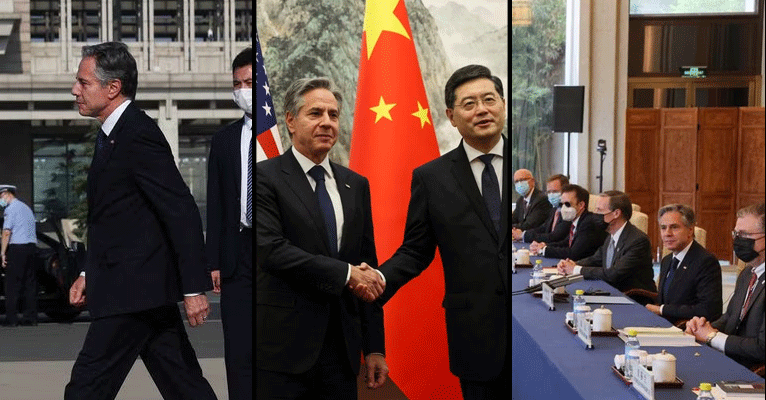BEIJING, June 18 (Reuters) – On Sunday, U.S. Secretary of State Antony Blinken commenced his visit to Beijing, becoming the first senior American diplomat to set foot in China in five years. However, with frosty relations between the two largest economies in the world, the chances of significant breakthroughs on their extensive list of disputes remain dim.
Blinken’s visit, originally planned for February but postponed due to a suspected Chinese spy balloon over U.S. airspace, marks the highest-level visit to China by a U.S. government official since President Joe Biden assumed office in January 2021.
Chinese Foreign Minister Qin Gang welcomed Blinken and his delegation at the entrance of a villa within the premises of Beijing’s Diaoyutai State Guest House, deviating from the customary protocol of hosting such meetings inside the building.
As they walked in, Qin engaged in small talk with Blinken, inquiring about his long journey from Washington. They then proceeded to shake hands in front of both the Chinese and American flags.
Once inside the meeting room, neither Blinken nor Qin made any comments in the presence of the briefly permitted reporters.
Chinese Assistant Foreign Minister Hua Chunying, also attending the meeting, posted a picture of Qin and Blinken shaking hands on Twitter with the caption, “Hope this meeting can help steer China-U.S. relations back to what the two Presidents agreed upon in Bali.”
During his stay until Monday, Blinken is expected to meet with China’s top diplomat Wang Yi and possibly President Xi Jinping.
U.S. officials have tempered expectations of major breakthroughs during this visit. However, they emphasize that Blinken’s primary objective is to establish transparent and enduring communication channels to prevent the strategic rivalry between the two nations from escalating into a conflict.
Analysts and U.S. officials anticipate that Blinken’s visit will lay the groundwork for future bilateral meetings between Washington and Beijing, potentially involving trips by Treasury Secretary Janet Yellen and Commerce Secretary Gina Raimondo. Furthermore, it could pave the way for meetings between President Xi and President Biden at multilateral summits later this year.
When asked on Sunday about the balloon incident in February, President Biden stated that he believed the Chinese leadership had limited knowledge of the balloon’s whereabouts and activities. He expressed his hope to meet President Xi soon, saying, “I’m hoping that, over the next several months, I’ll be meeting with Xi again and talking about legitimate differences we have but also how there are areas we can get along.”
Biden and Xi held their much-anticipated first face-to-face talks in November on the Indonesian island of Bali, during a summit of the Group of 20 major economies. The discussions addressed sensitive topics such as Taiwan and North Korea, but the leaders also pledged to increase the frequency of communication.
Although this meeting briefly alleviated concerns about a new Cold War, tensions rose with the flight of the Chinese balloon over the United States a few months later, resulting in scarce high-level communication between the two nations.
RISING RISK OF MISCALCULATION
Relations between the United States and China have deteriorated significantly across various fronts, raising concerns that they may eventually clash militarily over Taiwan, a self-governed island that China claims as its own. Disputes also persist over trade, U.S. efforts to limit China’s semiconductor industry, and Beijing’s human rights record.
Blinken’s visit will be closely monitored worldwide, as any escalation between these superpowers could have far-reaching consequences,
affecting financial markets, trade routes, global supply chains, and more.
A senior State Department official, during a refueling stop in Tokyo en route to Beijing, highlighted the mutual recognition of the need for high-level communication channels. They stated, “We are at an important point in the relationship where I think reducing the risk of miscalculation, or as our Chinese friends often say, stopping the downward spiral in the relationship, is something that’s important.”
China’s reluctance to engage in regular military-to-military talks with the United States has particularly alarmed its neighboring countries.
Before departing for Beijing, Blinken outlined the three main objectives of his trip at a press conference. These objectives include establishing crisis management mechanisms, advocating for U.S. and allied interests, addressing concerns directly, and exploring potential areas of cooperation.
He also mentioned that he would raise the issue of U.S. citizens detained in China on politically motivated charges.
Furthermore, Blinken and his delegation are likely to discuss increasing commercial flights between the two countries and curbing the flow of fentanyl precursors from China. U.S. officials, however, caution against setting high expectations for success.
“One side is well aware of the current state of the bilateral relationship. We’re coming here in an effort to make sure that we can manage it responsibly,” said a U.S. official.

